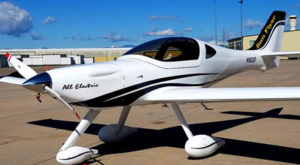 Recently, aviation titles chronicled the rollout of Sun Flyer’s prototype electric powered airplane. To careful observers, the aircraft might appear somewhat familiar. Good eyes, folks. The prototype was built for Aero Electric Aircraft Corporation by Arion Aircraft. The beautiful sweeping lines of the Sun Flyer are nearly identical to the Lightning LS-1.
Recently, aviation titles chronicled the rollout of Sun Flyer’s prototype electric powered airplane. To careful observers, the aircraft might appear somewhat familiar. Good eyes, folks. The prototype was built for Aero Electric Aircraft Corporation by Arion Aircraft. The beautiful sweeping lines of the Sun Flyer are nearly identical to the Lightning LS-1.
The one notable difference — and in fact this is the whole story — is the electric motor up front allowing Sun Flyer to look even a bit more streamlined than the dashing outline of Lightning. This is a first article aircraft as photos don’t yet show any solar cells on the wings, as promised by Aero Electric.
Regardless of how AEAC develops Sun Flyer down the line, it was wonderful to see them linking up with Arion Aircraft whose LSA and kit models have been admired for their gracefully smooth shape for some years.
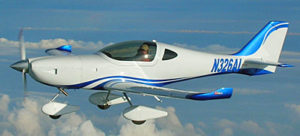
Arion Aircraft’s Lightning LS-1, available as a Special Light-Sport Aircraft or a kit. The shape works for Aero Electric’s Sun Flyer vision.
In its unveiling at AirVenture 2014, Aero Electric showed a single seater. This was actually the Elektra One, designed and created by Calin Gologan, who also predicts an all-electric four-seat GA airplane in the next ten years. That was 2010, so we have time for AEAC to get their two seater ready and move onward. (We’ll see how that turns out.)
Paying tribute to Calin, George Bye of Aero Electric said, “[Our] two-seat solar-electric light sport aircraft project was created under license agreement from German technology partner, PC-Aero, which introduced the Elektra One single-seater.”
Readers seeking a broader view are invited to read my survey of electric airplanes from a few years ago: electric airplane review. A year earlier, we had this earlier article about Elektra. Now, you have some of the history.
Most of the electric airplane projects currently capturing media attention are pure electric plays, although Aero 2016’s e-flight-expo organized by German publisher Willi Tacke showed a hybrid (gas & electric) project. Other than some fascinating one-off projects, pure electric mostly means batteries to supply the current needed to spin the engine and prop.
AEAC’s Sun Flyer is the first “commercial” project proposing to incorporate solar cells as a power-gathering apparatus. The company stated, “Solar energy collection from solar cells affixed to the composite wing skin, produces electric power that is combined with Lithium Ion batteries to run the electric propulsion system.”
Flying the eSpyder a couple years ago showed it was both easy and different for the pilot. While operation was simple, I had unfamiliar information references I needed to track. They were not intuitive for someone used to fuel flow, magneto operation, tank capacity, and power settings. You can read my flight impressions aloft in eSpyder. Alternatively, watch this video with airframe developer, Tom Peghiny, after eSpyder became the first electric airplane to win German certification.
Speaking to the pilot operation of Sun Flyer, Aero Electric reported, “The electric motor’s throttle is very intuitive with one control lever. [The pilot has] no need to adjust mixture richness and monitor cylinder head temperature as in aircraft with internal combustion engines; a throttle computer control unit is responsible for optimum motor operation, battery status and the entire power system.”
Beyond its quiet, drip-free operation, “fuel burn” is another saving grace of electric. AEAC said, “Only about $1 of electricity is needed for each flying hour.” We’ve heard this number from other producers and it seems to suggest this could be great for flight schools trying to operate efficiently. Even the fuel miserly Rotax 912 iS burns four gallons an hour and even at today’s somewhat lower auto gas prices, that still translates to at least $10 per hour for fuel alone.
Swapping out battery sets (and fast charging) could keep an electric flight school plane flying almost continuously, augmented by Sun Flyer’s solar cells, but of course, batteries are some of the most expensive components so to buy at least two sets per airplane on top of the cost of a new airplane may be a deal breaker for smaller flight schools. AEAC has hinted at a price of $180,000, a bit precious for many flight schools. A breakthrough in energy storage (i.e., better batteries) could dramatically alter the landscape but we’re still waiting for long-lasting, fast-charging batteries that don’t cost a fortune.
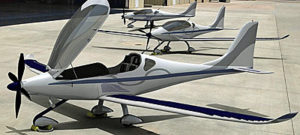
This artist’s rendition shows Sun Flyer with wings equipped with solar cells to aid battery recharging.
Regardless, the appeal of quiet, trouble-free electric propulsion generates significant interest from many both in the pilot community and from neighbors, community leaders, and various interest groups. The move to electric seems inexorable driven even faster by the arrival of names like Airbus and its Voltair subsidiary (for more, read this and this) or giant Siemens. AEAC and its Sun Flyer may be coming in to view at just the right time. We’ll keep watching them.
In this ANN video, company boss George Bye gives his vision for the future of Sun Flyer and electric propulsion.


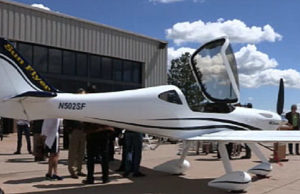
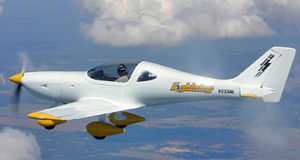
Leave a Reply